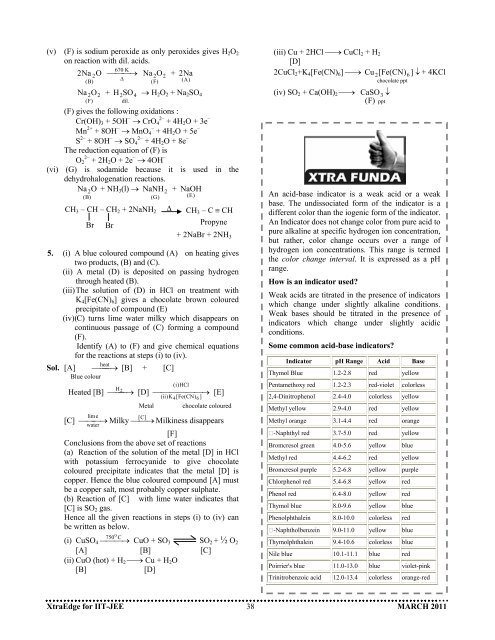March 2011 - Career Point
March 2011 - Career Point
March 2011 - Career Point
You also want an ePaper? Increase the reach of your titles
YUMPU automatically turns print PDFs into web optimized ePapers that Google loves.
(v) (F) is sodium peroxide as only peroxides gives H 2 O 2<br />
on reaction with dil. acids.<br />
2 Na 2 O<br />
(B)<br />
⎯<br />
Na 2O 2 +<br />
(F)<br />
670 ⎯⎯<br />
K →<br />
∆<br />
(F)<br />
Na 2O 2 +<br />
2 Na<br />
(A)<br />
H 2 SO 4 → H 2O 2 + Na 2 SO 4<br />
dil.<br />
(F) gives the following oxidations :<br />
Cr(OH) 3 + 5OH – → CrO 2– 4 + 4H 2 O + 3e –<br />
Mn 2+ + 8OH – → MnO – 4 + 4H 2 O + 5e –<br />
S 2– + 8OH – → SO 2– 4 + 4H 2 O + 8e –<br />
The reduction equation of (F) is<br />
O 2– 2 + 2H 2 O + 2e – → 4OH –<br />
(vi) (G) is sodamide because it is used in the<br />
dehydrohalogenation reactions.<br />
Na + NH 3 (l) →<br />
2O<br />
(B)<br />
NaNH +<br />
(G)<br />
CH 3 – CH – CH 2 + 2NaNH 2<br />
Br<br />
Br<br />
2<br />
∆<br />
NaOH<br />
(E)<br />
CH 3 – C ≡ CH<br />
Propyne<br />
+ 2NaBr + 2NH 3<br />
5. (i) A blue coloured compound (A) on heating gives<br />
two products, (B) and (C).<br />
(ii) A metal (D) is deposited on passing hydrogen<br />
through heated (B).<br />
(iii) The solution of (D) in HCl on treatment with<br />
K 4 [Fe(CN) 6 ] gives a chocolate brown coloured<br />
precipitate of compound (E)<br />
(iv) (C) turns lime water milky which disappears on<br />
continuous passage of (C) forming a compound<br />
(F).<br />
Identify (A) to (F) and give chemical equations<br />
for the reactions at steps (i) to (iv).<br />
Sol. [A]<br />
Blue colour<br />
Heated [B]<br />
⎯ heat ⎯→ [B] + [C]<br />
lime<br />
H<br />
⎯⎯→<br />
2<br />
[D]<br />
Metal<br />
(i)HCl<br />
⎯ ⎯⎯⎯⎯⎯→<br />
[E]<br />
( ii)K4[Fe(CN)<br />
6 ]<br />
chocolate coloured<br />
[C] ⎯⎯ →Milky ⎯ [ ⎯→<br />
C]<br />
Milkiness disappears<br />
water<br />
[F]<br />
Conclusions from the above set of reactions<br />
(a) Reaction of the solution of the metal [D] in HCl<br />
with potassium ferrocyanide to give chocolate<br />
coloured precipitate indicates that the metal [D] is<br />
copper. Hence the blue coloured compound [A] must<br />
be a copper salt, most probably copper sulphate.<br />
(b) Reaction of [C] with lime water indicates that<br />
[C] is SO 2 gas.<br />
Hence all the given reactions in steps (i) to (iv) can<br />
be written as below.<br />
(i) CuSO 4 ⎯<br />
750o ⎯⎯<br />
C → CuO + SO 3 SO 2 + ½ O 2<br />
[A] [B] [C]<br />
(ii) CuO (hot) + H 2 ⎯→ Cu + H 2 O<br />
[B]<br />
[D]<br />
(iii) Cu + 2HCl ⎯→ CuCl 2 + H 2<br />
[D]<br />
2CuCl 2 +K 4 [Fe(CN) 6 ] ⎯→ Cu [Fe(CN)<br />
(iv) SO 2 + Ca(OH) 2 ⎯→<br />
2 6]<br />
chocolate ppt<br />
CaSO3<br />
↓<br />
(F) ppt<br />
↓ + 4KCl<br />
An acid-base indicator is a weak acid or a weak<br />
base. The undissociated form of the indicator is a<br />
different color than the iogenic form of the indicator.<br />
An Indicator does not change color from pure acid to<br />
pure alkaline at specific hydrogen ion concentration,<br />
but rather, color change occurs over a range of<br />
hydrogen ion concentrations. This range is termed<br />
the color change interval. It is expressed as a pH<br />
range.<br />
How is an indicator used?<br />
Weak acids are titrated in the presence of indicators<br />
which change under slightly alkaline conditions.<br />
Weak bases should be titrated in the presence of<br />
indicators which change under slightly acidic<br />
conditions.<br />
Some common acid-base indicators?<br />
Indicator pH Range Acid Base<br />
Thymol Blue 1.2-2.8 red yellow<br />
Pentamethoxy red 1.2-2.3 red-violet colorless<br />
2,4-Dinitrophenol 2.4-4.0 colorless yellow<br />
Methyl yellow 2.9-4.0 red yellow<br />
Methyl orange 3.1-4.4 red orange<br />
-Naphthyl red 3.7-5.0 red yellow<br />
Bromcresol green 4.0-5.6 yellow blue<br />
Methyl red 4.4-6.2 red yellow<br />
Bromcresol purple 5.2-6.8 yellow purple<br />
Chlorphenol red 5.4-6.8 yellow red<br />
Phenol red 6.4-8.0 yellow red<br />
Thymol blue 8.0-9.6 yellow blue<br />
Phenolphthalein 8.0-10.0 colorless red<br />
-Naphtholbenzein 9.0-11.0 yellow blue<br />
Thymolphthalein 9.4-10.6 colorless blue<br />
Nile blue 10.1-11.1 blue red<br />
Poirrier's blue 11.0-13.0 blue violet-pink<br />
Trinitrobenzoic acid 12.0-13.4 colorless orange-red<br />
XtraEdge for IIT-JEE 38 MARCH <strong>2011</strong>

















